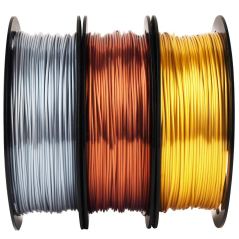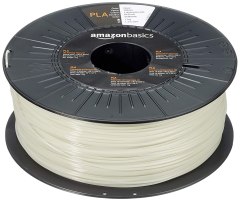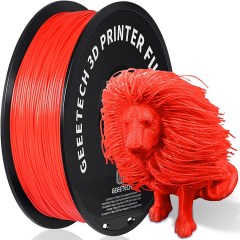BestReviews is reader-supported and may earn an affiliate commission. Details

A wholesale purchase of MIKA3D material is sure to keep your machine making quality models for a long time to come.
Bulk purchase savings. Reliably smooth prints. Shimmering finish. Material will not tangle. Made in a variety of vibrant colors. Works with all PLA machines. Available in 17 different bundle packs.
These spools are smaller than you may expect.

A purchase of Amazon Basics' material provides quite a bit of PLA material per spool.
Inexpensive. Available in glow-in-the-dark and dark gray. Large spools. Consistently smooth prints. Glossy finish. Easily fits most machines. Will not warp. Arrives in resealable bag.
Additional colors would be appreciated.

If you need tougher and more flexible prints, a spool of eSUN PLA PRO is a must-have for your workshop.
Affordable. Available in 21 vibrant colors. Much sturdier than the average PLA material. Bright glossy finish. Big spool. Will not tangle. Lasts a long time in storage. Will not clog printer head.
Creates more stringing than normal PLA material.

These budget-priced PLA spools make it easy to learn the basics without wasting material along the way.
Especially inexpensive. Arrives vacuum-sealed. Consistently smooth prints. Glossy finish. Easily fits most machines. Minimal stringing. Available in 20 color options.
Smaller prints may be a little brittle.

Once the lights go out, this option's patchwork of brilliant glowing colors will add flair to any model.
Offered in multiple sizes. Available in a variety of green, blue, and pink glow variants. Glows brightly when exposed to UV light. Works with most machines. Reliably smooth prints.
Boring white color during the day.

We recommend these products based on an intensive research process that's designed to cut through the noise and find the top products in this space. Guided by experts, we spend hours looking into the factors that matter, to bring you these selections.

If you have a 3D printer, you know it doesn’t use ink: it uses thin filaments on spools that are melted down and sprayed, layer by layer, to gradually build up a physical 3D item.
The kind of filament you need depends on what you’re trying to print and how it will be used or displayed. Will you make items that are mainly for display, or are you making something that needs to withstand a lot of abuse? Do your items need to conduct electricity or have a metallic finish? There are different filaments for each of those purposes and more.
Before you select filament for your 3D printer, you’ll need to make a few determinations. What should it be made of? All filaments are not created equal, and the differences can be important. Also, how much do you want to spend? 3D printing can be pricey, so you’ll want to make an informed decision.

Since 3D printer filaments aren’t all the same, you need to think about what you’re going to be printing before selecting a spool of filament. Decide what you’re going to use it for then get the filament that is best suited to that use. For instance:
Perhaps you’ll be making items to display, such as figurines, picture frames, and vases. This category would also include items that would be handled gently, such as chess pieces or key chain fobs.
Items in this category include toys for small children, mallets for hammering tent stakes, and camping dishes. Any item that might be subjected to a lot of abuse would be in this group.
Do you want to print food containers of any kind? If so, they need to meet the federal safety standards so you, your friends, and your family aren’t exposed to any toxins. You’ll need to use 3D printer filaments that are labeled “BPA-free.” BPA (bisphenol A) is an industrial chemical that dissolves and seeps into food if it is stored in a container that has BPA in it.
Extreme weather conditions, like the desert, impose temperature requirements on the products you print. If you’re going to be printing wind chimes for use in southern Arizona, for example, you need to use filaments that can take the heat out there.
This final category would include anything that has exotic requirements beyond the ordinary, such as:
Glow-in-the-dark products
Electrically conductive products
Products that change colors (mood rings)
Magnetic products
Flexible products (for shoes)
Precision gears
If you’re going to be printing anything that fits into one of those groups, there are specialty filaments to meet your needs.
3D printer filaments are made from a variety of plastics and plastic-like materials. Additives are often combined with the base materials to create exotic materials for special or professional uses.
Polylactic acid (PLA): This is the most popular filament material. It is environmentally friendly because it is biodegradable, being made from sugarcane and cornstarch. It doesn’t smell during the printing process like some filaments do. It’s brittle, though, so don’t use it for items like children’s toys or high-impact items that would go through lots of abuse. These filaments are available in a wide range of colors.
Acrylonitrile butadiene styrene (ABS): Not quite as popular as PLA, ABS is actually somewhat superior to it. It is somewhat more difficult to print with, but it is rugged. It can be used for making LEGO bricks, bicycle helmets, shin guards, and so on. These filaments are also available in a rainbow of colors.
Polyethylene terephthalate (PET): This is the most commonly used plastic anywhere in the world. Water bottles are made from it, as are some food containers and clothing fibers.
Nylon: While not as popular as others, nylon filament ranks number-one for durability, flexibility, and strength. Nylon has been around for a long time, and if you’re willing to take some extra time during the printing process, this is a good all-around choice.
Thermoplastic elastomers (TPE): This rubber-like plastic is used in automotive parts, medical supplies, and household appliances. It is flexible and durable. It’s a bit sticky to work with, but you can make flip-flops, wrist bands, and other flexible items with it.
So-called metal filaments are actually PLA or ABS with metal powder mixed in to give it the look and feel of aluminum, brass, bronze, copper, or stainless steel. Other metal powders can be added, too. Electrically conductive items and circuits can be printed this way, as can magnetic items that will stick just like a regular magnet.
PLA can be mixed with wood fibers such as bamboo, birch, cedar, cherry, cork, olive, pine, and willow to create printable objects that look like they are made out of wood. Other filaments can be used to print glow-in-the-dark creations or items that change colors in the heat, like a mood ring. PLA and ABS can be mixed with all sorts of additives to create new and exotic items on your printer.
3D printer filament such as PLA, ABS, PETG (a variation of PET), and nylon can be reinforced with carbon fibers to create very rigid, stiff, and lightweight materials for structural uses in all kinds of environments. Polycarbonate ABS alloy (PC-ABS) and Polyoxymethylene (POM) are widely used for industrial, telecommunication, and automotive applications. Additionally, they are widely used in engineering, especially for printing gears, camera focusing mechanisms, bearings, and zippers.
Filament prices are determined almost exclusively by the material they’re made from or the additives that are mixed with them to create more exotic characteristics. There is a considerable amount of overlap, so pricing categories are not cut-and-dried.
Low-priced filaments start around $8 per spool for plain white PLA filament. Colored PLA filaments range as high as $19 per spool.
Mid-range filaments start at $19 to $20 per spool up to $29 per spool for premium PLA and ABS filaments. Wood fiber additives and cheap metal filaments will be in this range.
High-end filaments are anything over $30 per spool. These include exotic uses and additives for transparent and/or professional filaments.

3D printer filaments have become standardized over time and will be usable in most of the 3D printers available.
Unless you’re doing monochromatic (single color) printing, you should get at least one package of multicolored filaments. Each package usually has at least 10 feet of filament for each color.
Always use filaments from the same manufacturer to ensure they have the same melting points. If they have different melting points, you could end up with a jam in your extruder.
Read the label on each spool when you get it. The shelf life of most filaments is limited, so be sure to check the expiration date as soon as it arrives.

Q. Are 3D printer filaments environmentally friendly?
A. No. Except for PLA, 3D materials are mainly different forms of plastics, which do not biodegrade.
Q. What does the ‘G’ in PETG stand for?
A. Glycol-modified. PETG filaments are clearer and less brittle than the base filament, PET, so they’re gradually overtaking it for making transparent or thin-walled items.
Q. What is the best 3D filament for most applications overall?
A. Nylon. It’s not the most popular or easiest to use, but it has the widest application.
Q. What are the most popular 3D printed items?
A. Containers, vases, lamps, doorstops, toothpaste tube squeezers, and spare keys are popular.
Get emails you’ll love.
Learn about the products you’re wondering if you should buy and get advice on using your latest purchases.
